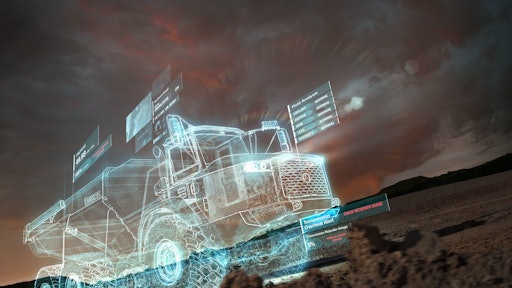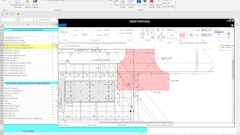
During the last downturn contractors began carefully monitoring operating costs utilizing tools such as telematics system data. Telematics is not new. It has been around for over 12 years, but it is just gaining a foothold as contractors discover the possibilities and major OEMs offer the product as standard.
“It has caught people’s imagination,” says John Patterson, former CEO and President of JCB, who rose through the ranks from a field engineer. “That will only grow with time and as people become comfortable with the whole concept. I think as the popularity increases, the cost of telematics will decrease, as well. iPhones are only a fraction of the cost today as they were 10 years ago. That will ripple through the industry, as well.”
Telematics makes it possible to capture and utilize data that was previously difficult to acquire. “We have tools available now that we did not have in the past,” says Bruce Boebel, senior product manager for tracked products, Komatsu America. “With tools like KOMTRAX, we can drill down and find out how each machine is being used. In the past, customers just knew average estimates of what they were using for fuel consumption.”
Now, it is possible to track fuel consumption on specific jobs along with relevant data regarding idle time and how hard the machine is being used. This more accurate and timely data allows you to better analyze best practices.
“The data the customer collects can enhance the efficiency and profitability of the business considerably,” says Patterson. “From the manufacturers’ perspective, we have access to data that we never had before on how equipment is used, the different cycles that it is put through, fuel efficiency, oil consumption, and it acts as a very good anti-theft tool, as well. Customers and manufacturers can see where the products are.
“I don’t think it has been fully grasped yet by the marketplace as to the full benefits that are derived from it,” he adds. “That is a time issue and it is an expertise issue as people become more comfortable with telematics.”
Telematics systems provide operational productivity measurements back to the customers. “Today, a person who owns a fleet can identify operators who need training and closely track equipment utilization,” says Brian Rauch, senior vice president of engineering, manufacturing and supply management, Deere & Company. “I can see that I have a 45-metric-ton excavator that seems to be at idle too often. I know I need more dump trucks at the site because the last thing I want is my excavator sitting because I don’t have enough trucks.”
End-user experience is driving increased popularity. “It is at a critical mass where people can calculate a real return,” says Rauch. “Contractors are starting to take notice of the value and they are convinced if they are not using it, they are falling behind their competition.”
Ongoing Evolution
The amount of data available will only continue to rise.
“Case launched the SiteWatch telematics system in 2013, and the industry continues to see the customer adoption rise daily,” says Brad Stemper, solutions marketing manager, Case Construction Equipment. “We’ve recently increased the number of parameters monitored (up to 40 on each product line), allowing all tracked parameters to be recorded, which eliminates the need for equipment owners to choose the most important, providing a robust data set to monitor and make intelligent business decisions.”
And telematics systems will continue to evolve. “KOMTRAX was founded by Komatsu many years ago,” notes Boebel. “But it is not the same KOMTRAX that is used today, nor will it be the same that is offered tomorrow. We are constantly improving KOMTRAX to provide more usable information for the customer, to be able to track the health of the fleet and use that in many ways to build better products for the customer and to give them better tools to manage their equipment.
But telematics is only the tip of the information revolution. “Advances in onboard machine computing, display, wireless communication technology and positioning technologies, including GPS, provided the enabling technologies to revolutionize earthmoving in construction,” says Chuck Sahm, automation and enterprise solutions manager, Caterpillar. “Efficient construction operation demands that the right people have the right information at the right time.”
Caterpillar’s Computer Aided Earthmoving System (CAES) was an early example of how technology could be applied to provide a means for machine operators to view plans immediately after they are created, and then use earthmoving equipment as a survey instrument while the work is performed.
“In addition to providing terrain data, other information, such as productivity and machine utilization, was also made available,” says Sahm.
The system utilizes 3D designs, GPS and wireless communications to integrate design, planning and operations. It delivers real-time information to operators and the office. In addition, machine control and guidance products such as AccuGrade, Cat Grade Control and Cat Compaction Control provide connectivity between the field and office.
Personal Device Connectivity
Personal device technology, such as smartphones, can be used to communicate directly with the machine. There is already technology that allows an operator to view fault codes and monitor usage with a personal electronic device (tablet or smartphone).
But such technology holds more potential. It could also be utilized to store individual preferences for machine settings. For example, a hydraulic system supplier we visited last fall was experimenting with the Bluetooth capability of today’s personal electronic devices. The concept was to enable operators to enter their preferred operating settings via an app in their smartphone or tablet. Once the machine was started, it would then connect to the personal device via Bluetooth and download the operator settings into the machine.
The explosion in the use of smartphones and tablets has forever changed the shape of the industry. “There are 5 billion people out there right now doing something with their phone in some form or another,” says Andy Wendling, EMSolutions deployment manager, Caterpillar. “We all leave a digital trail... that endless stream of phone records, history, points we have visited on our GPS. That doesn’t go away and is there forever.”
To capitalize on this reality, Caterpillar has developed EMSolutions with the goal to communicate more through mobile devices. “What used to be done by a face-to-face visit and a handshake now is done remotely with a few clicks on a tablet, smartphone or whatever tool it may be with VisionLink to get that information off of our product,” says Wendling.
The goal is to provide the contractor with the information they want, when they want it and how they want it. The enormity of this challenge comes more into focus when you consider the amount of data that has been collected through Caterpillar’s ProductLink alone.
“There are over 5 billion ProductLink records in the database,” says Wendling. “We have a database of over 5 million fluid samples — whether that be fuel, coolant or oil being processed by our SOS labs at any given time. There are over 700,000 inspections in our database that we are trying to aggregate through the cloud to ultimately help our customers.
“There is no way our customers — without EMSolutions or our trained dealers — could actually go out and process all of that information,” he points out. “They would quickly drown and get lost in that flood of data.”
Digital Jobsite Emerges
The explosion of personal electronic devices, coupled with the data generated from telematics systems, mapping software and interconnected accounting and project management systems, is making the digital jobsite a reality. It is becoming possible to share information — from change orders to machine utilization — instantly in real time.
The recent generation of accounting software is capable of collecting and populating much electronic data, eliminating the manual entry required in the past. Time sheet data can be entered on your personal electronic device and immediately transmitted to the proper job costing application. Machine utilization can be carefully tracked and automatically assigned to the proper project. Maintenance scheduling becomes automated and change orders are automatically transmitted to all affected parties. No more searching for the most current plans. Everyone has the same information.
“Within the construction site’s operations, we see the digital connected site as a key enabler to the overall job’s productivity, improved safety and higher quality finish,” says Ryan Kunisch, director of marketing, Trimble Civil Engineering and Construction. “Solutions are becoming increasingly integrated across the entire construction project life cycle, from the owner, to the engineer, to the contractor.
“Today, we offer a wide range of on-machine solutions, mobile field solutions and office software solutions that can all link into the connected digital ecosystem around the site,” he continues. “Furthermore, our strength and understanding of the digital construction site enables us to optimize earlier product planning phases and close the loop between real-time information from the field to the office, improving planning and reducing latency between updates to the schedule. This overall enables a faster and more efficient project.”



























